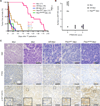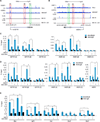Kinase and BET Inhibitors Together Clamp Inhibition of PI3K Signaling and Overcome Resistance to Therapy
- PMID: 26058079
- PMCID: PMC4918409
- DOI: 10.1016/j.ccell.2015.05.006
Kinase and BET Inhibitors Together Clamp Inhibition of PI3K Signaling and Overcome Resistance to Therapy
Abstract
Unsustained enzyme inhibition is a barrier to targeted therapy for cancer. Here, resistance to a class I PI3K inhibitor in a model of metastatic breast cancer driven by PI3K and MYC was associated with feedback activation of tyrosine kinase receptors (RTKs), AKT, mTOR, and MYC. Inhibitors of bromodomain and extra terminal domain (BET) proteins also failed to affect tumor growth. Interestingly, BET inhibitors lowered PI3K signaling and dissociated BRD4 from chromatin at regulatory regions of insulin receptor and EGFR family RTKs to reduce their expression. Combined PI3K and BET inhibition induced cell death, tumor regression, and clamped inhibition of PI3K signaling in a broad range of tumor cell lines to provide a strategy to overcome resistance to kinase inhibitor therapy.
Copyright © 2015 Elsevier Inc. All rights reserved.
Figures







References
-
- Bader AG, Kang S, Zhao L, Vogt PK. Oncogenic PI3K deregulates transcription and translation. Nat. Rev. Cancer. 2005;5:921–929. - PubMed
-
- Bendell JC, Rodon J, Burris HA, de Jonge M, Verweij J, Birle D, Demanse D, De Buck SS, Ru QC, Peters M, et al. Phase I, dose-escalation study of BKM120, an oral pan-Class I PI3K inhibitor, in patients with advanced solid tumors. J. Clin. Oncol. 2012;30:282–290. - PubMed
Publication types
MeSH terms
Substances
Grants and funding
LinkOut - more resources
Full Text Sources
Other Literature Sources
Medical
Molecular Biology Databases
Research Materials
Miscellaneous

